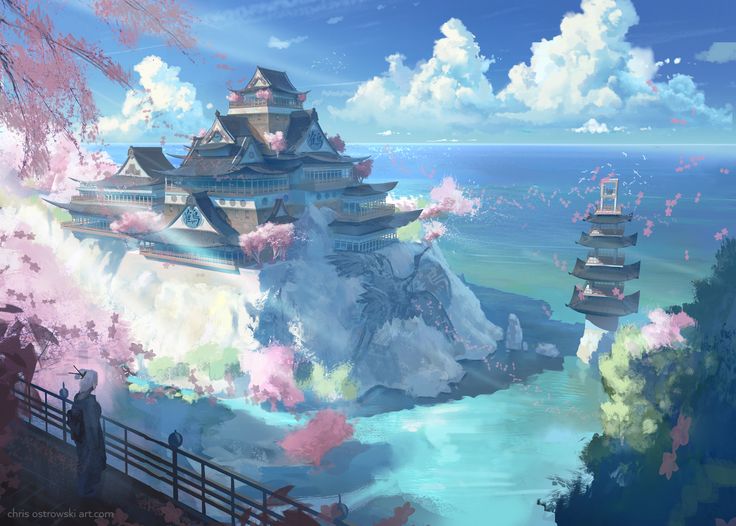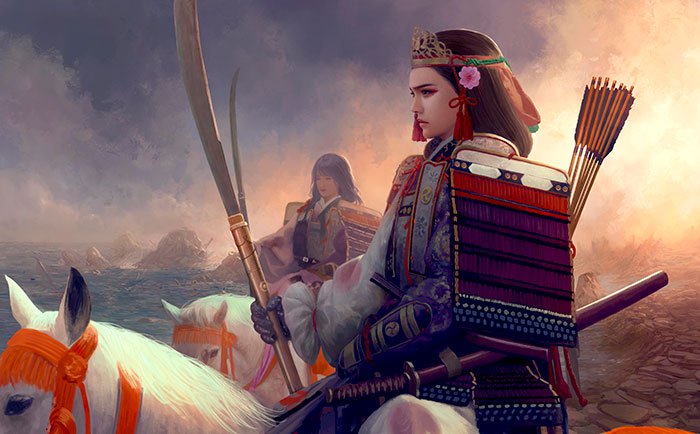Fujiwara Family
Kōnotori Castle, standing sentinel over the Hikawa River inlet.
To understand the Fujiwara, one must understand Yamatai.
On the far side of the world ocean, ancient and indomitable, blessed with timeless beauty, rich in culture... Almighty Yamatai is as decadent as it is deadly to the uninitiated.
Ruled by an Emperor revered as chosen by the gods but controlled from the shadows by powerful Imperial Clans, Yamatai is an empire steeped in old traditions and riddled with contradictions. Soaring mountains pierce the skies, their crowns cloud-wreathed and glittering with powdery snow. Between these, in picturesque valleys of verdant green, are scattered settlements of fragrant hardwood surrounded by acres devoted to terraced wet rice cultivation. Along the coastlines and pristine beaches rise mighty castles and sprawling cities.
As the hues of nature change with the seasons, so too do the people of Yamatai with their vibrant yukatas and kimonos, now lavender for spring or vermilion in summer, perhaps rich auburn in autumn, or robin's blue in the depths of winter; there is no colour that cannot be found in Yamatai. Life too, is equally vibrant: outsiders are consistently amazed by the ancient and inscrutable traditions that the Yamatai practice. These embody form in function, breathing art into the mundane.
Yet underneath the splendor and glory lies a nation riddled with lethal politics. The nobility hail from clans that claim ancestry from ancient heroes of Yamatai myth, and all consider themselves entitled to power and prestige. The Emperor may rule by divine will, but his advisers are very much human. When egos clash, blood is spilled, and a family rises or falls in favour.
The Fujiwara, Former Retainers to the Chrysanthemum Throne
The Fujiwara were one of the great families of Yamatai. For untold years they held places of honour within the Imperial Court. Favours were theirs to grant or withhold with the authority of the Emperor himself.
Now, they are scattered. Weakened by decades of infighting among the courtly clans, the prestige of the Fujiwara has all but slipped into obscurity.
Fujiwara-no-Kaguya's long and arduous journey marks an attempt for a brighter future in a new land. Having made landfall in the Lurian Hegemony on the continent of Dwilight, Kaguya's task is a tall order; the Fujiwara scion must establish herself and the name of her highborn clan among fresh peoples and new courts.
Will the ancient traditions of her family, honed by her ancestors over generations, serve her well in this foreign land?
Only time will tell.
The Arts of War and Peace
A princess of Yamatai with her loyal retainer. Both are clad for war.
All highborn families are ranked as bushi (warriors), and are required to defend threats to the Chrysanthemum Throne. As the ramifications of shirking away from this sacred duty are serious, it is common for both male and female nobles to have at least rudimentary military training.
The legends speak of a hero who once shot down seven suns so that man would flourish under more comfortable conditions. As such, mastery of the Yamatai longbow (the daikyu) is held in the highest esteem in the Empire. Archery is so central to Yamatai warfare that it is rare to find a family, noble or otherwise, that does not own at least one serviceable longbow.
While other mainstay weapons exist, the preeminence of the bow is such that Yamatai armour is designed to allow efficient archery. Of these, Ō-yoroi is the only form deemed suitable for use by the warrior nobility. This ancient and complex type of battle armour is comprised of large lamellar plates made from individual metal scales to protect vital regions such as the head, torso, upper arms and legs. Separate articles are generally worn to protect the extremities. These are often brightly coloured and feature embroidery that represents the warrior's allegiances to their clan. As each suit of armor is difficult to manufacture and highly personalised, Ō-yoroi are treated with reverence; they are always placed in positions of prominence when not in use, and permission must be sought before handling another noble's Ō-yoroi.

